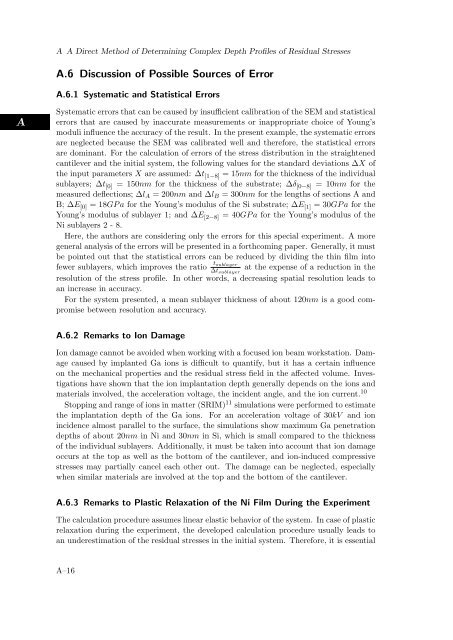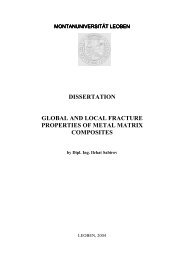1 - Erich Schmid Institute
1 - Erich Schmid Institute
1 - Erich Schmid Institute
You also want an ePaper? Increase the reach of your titles
YUMPU automatically turns print PDFs into web optimized ePapers that Google loves.
A<br />
A A Direct Method of Determining Complex Depth Profiles of Residual Stresses<br />
A.6 Discussion of Possible Sources of Error<br />
A.6.1 Systematic and Statistical Errors<br />
Systematic errors that can be caused by insufficient calibration of the SEM and statistical<br />
errors that are caused by inaccurate measurements or inappropriate choice of Young’s<br />
moduli influence the accuracy of the result. In the present example, the systematic errors<br />
are neglected because the SEM was calibrated well and therefore, the statistical errors<br />
are dominant. For the calculation of errors of the stress distribution in the straightened<br />
cantilever and the initial system, the following values for the standard deviations ∆X of<br />
the input parameters X are assumed: ∆t [1−8] = 15nm for the thickness of the individual<br />
sublayers; ∆t [0] = 150nm for the thickness of the substrate; ∆δ [0−8] = 10nm for the<br />
measured deflections; ∆lA = 200nm and ∆lB = 300nm for the lengths of sections A and<br />
B; ∆E [0] = 18GP a for the Young’s modulus of the Si substrate; ∆E [1] = 30GP a for the<br />
Young’s modulus of sublayer 1; and ∆E [2−8] = 40GP a for the Young’s modulus of the<br />
Ni sublayers 2 - 8.<br />
Here, the authors are considering only the errors for this special experiment. A more<br />
general analysis of the errors will be presented in a forthcoming paper. Generally, it must<br />
be pointed out that the statistical errors can be reduced by dividing the thin film into<br />
fewer sublayers, which improves the ratio tsublayer<br />
at the expense of a reduction in the<br />
∆tsublayer<br />
resolution of the stress profile. In other words, a decreasing spatial resolution leads to<br />
an increase in accuracy.<br />
For the system presented, a mean sublayer thickness of about 120nm is a good compromise<br />
between resolution and accuracy.<br />
A.6.2 Remarks to Ion Damage<br />
Ion damage cannot be avoided when working with a focused ion beam workstation. Damage<br />
caused by implanted Ga ions is difficult to quantify, but it has a certain influence<br />
on the mechanical properties and the residual stress field in the affected volume. Investigations<br />
have shown that the ion implantation depth generally depends on the ions and<br />
materials involved, the acceleration voltage, the incident angle, and the ion current. 10<br />
Stopping and range of ions in matter (SRIM) 11 simulations were performed to estimate<br />
the implantation depth of the Ga ions. For an acceleration voltage of 30kV and ion<br />
incidence almost parallel to the surface, the simulations show maximum Ga penetration<br />
depths of about 20nm in Ni and 30nm in Si, which is small compared to the thickness<br />
of the individual sublayers. Additionally, it must be taken into account that ion damage<br />
occurs at the top as well as the bottom of the cantilever, and ion-induced compressive<br />
stresses may partially cancel each other out. The damage can be neglected, especially<br />
when similar materials are involved at the top and the bottom of the cantilever.<br />
A.6.3 Remarks to Plastic Relaxation of the Ni Film During the Experiment<br />
The calculation procedure assumes linear elastic behavior of the system. In case of plastic<br />
relaxation during the experiment, the developed calculation procedure usually leads to<br />
an underestimation of the residual stresses in the initial system. Therefore, it is essential<br />
A–16
















